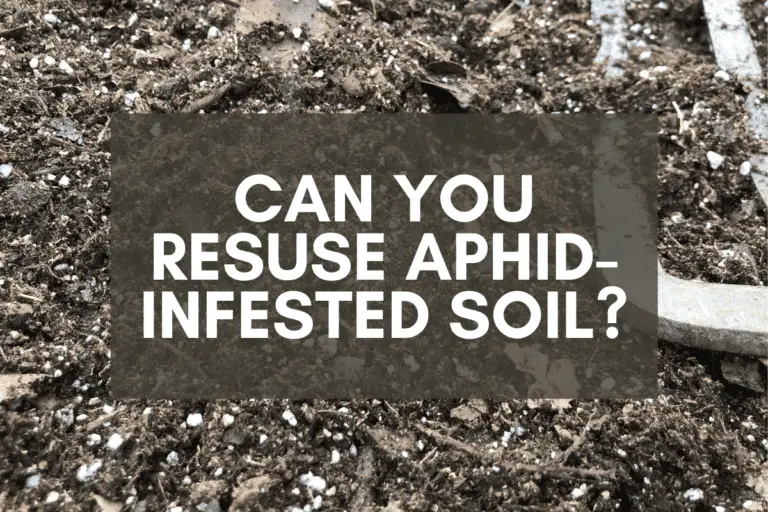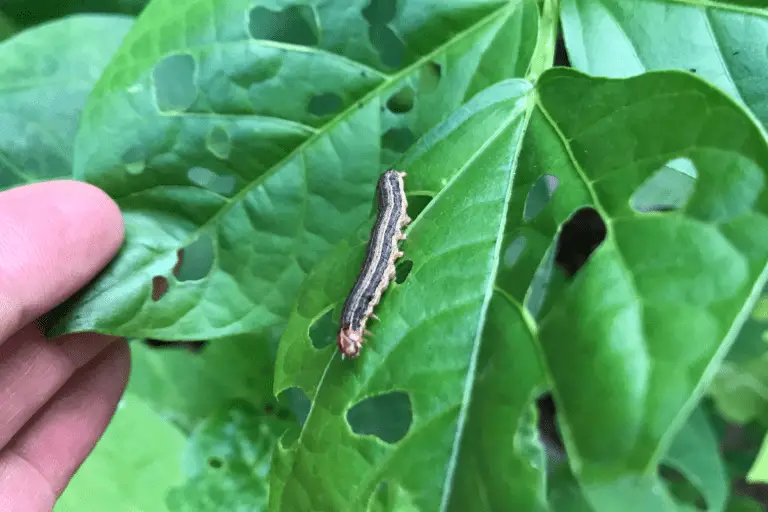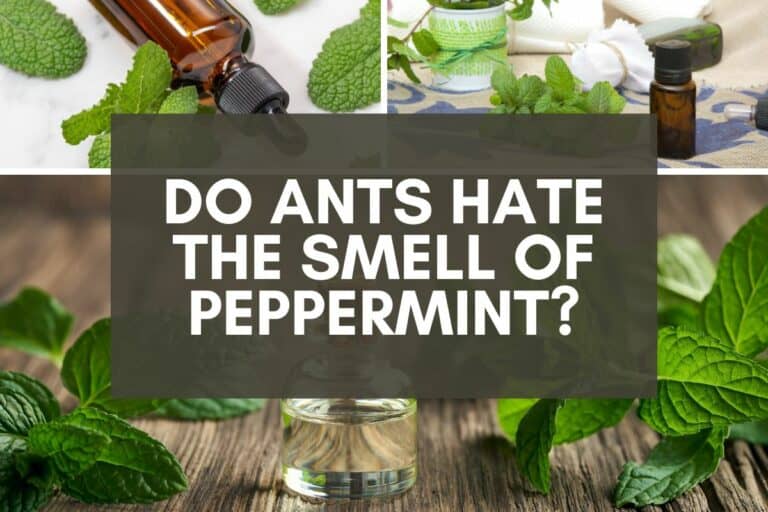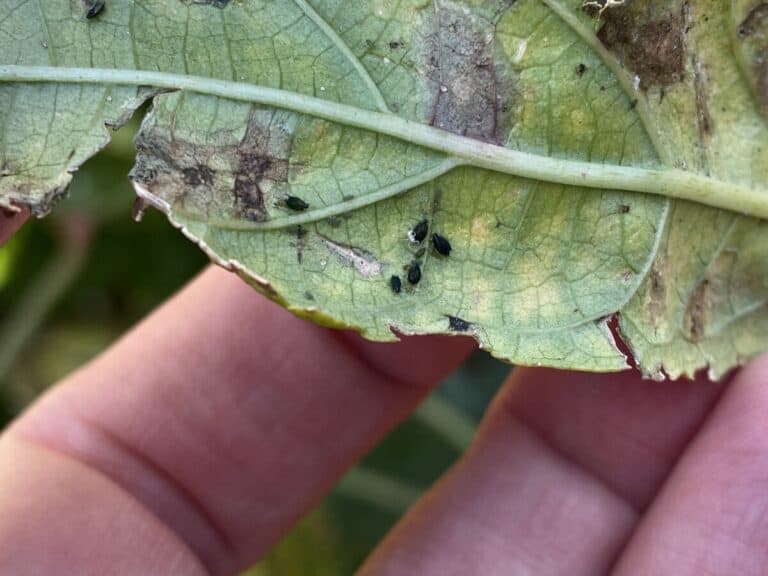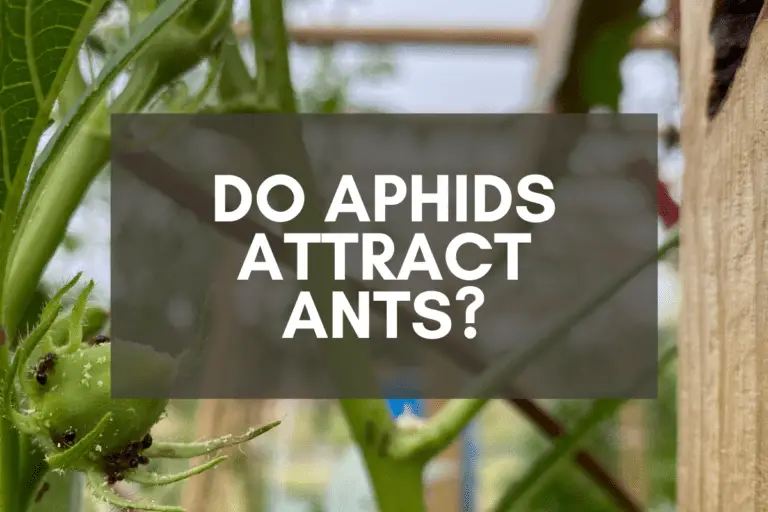7 Simple Ways to Keep Ants Off Your Pea Plants
Ants can be a real problem in gardening, and they can be especially pesky when they’re attracted to your pea plants.
Understanding why ants are attracted to pea plants is the first step in effectively getting rid of them and keeping your plants healthy.
When it comes to getting rid of ants on pea plants, first check for aphids, then use soapy water and neem oil sprays to get rid of any aphid infestations. If no aphids are visible on the pea plants, spray the ants with an orange oil or pyrethrin solution or use diatomaceous earth or bait traps.
In this article, I’ll cover the following topics:
- why ants are drawn to your pea plants
- What you can do to get rid of them and keep them away.
With the exception of leafcutter ants (which will damage your plants) and fire ants (which sting), ants aren’t normally something I worry too much about.
They’ll crawl all over many kinds of plants–from beans, carrots, and lettuce to okra, peppers, and tomatoes–but what draws them to these plants is what draws them just about anywhere: They’re searching for food.
If you see ants on your plants, don’t freak out. But please be aware that you might have other problems going on in your garden, so it’s best to know why they’re there and what to look out for.
Why Are Ants on My Pea Plants?
Ants are attracted to pea plants for a variety of reasons. If you know why the ants have shown up on your plants, you’ll be able to figure out how to get rid of them.
With that in mind, I’d like to cover the likely reasons why ants are showing up in your garden and climbing all over your pea plants.
1. Aphids and Honeydew Droplets

Aphids are a common pest that feed on the sap of pea plants, and ants are attracted to the sweet, sugary honeydew droplets that aphids excrete and will protect aphids in exchange for this food source.
Ants play a significant role in the life cycle of aphids and provide protection, ensuring the survival of their honeydew-producing friends.
This relationship is mutually beneficial, with ants guarding the aphids and gathering the sugary honeydew they produce. They’ll protect aphids from predators such as ladybugs and lacewing larvae in exchange for honeydew.
Ants have long been observed “herding” aphids, carrying them from plant to plant to find fresh food sources as well as fiercely defending them from other predators. The ants’ aggressive behavior makes it difficult for other insects to get close enough to the aphids to feed on them, thus ensuring the survival of the aphids and the food source for the ants.
However, this relationship can be harmful to your pea plants because the ants will kill off those beneficial insects that would have otherwise helped control the aphid population.
2. Extrafloral Nectaries and Flower Nectar
Extrafloral nectaries are specialized plant structures that produce nectar outside of the plant’s flowers. This nectar serves as a food source for insects, such as ants, that might protect the plant from herbivores and other threats.
But ants will occasionally seek out flower nectar as well, either because they’re searching for the nectar itself or because they’ve been attracted to aphids, which often like to gather on or near the flowers.
What’s interesting about this dynamic is the fact that ants are in the driver’s seat, so to speak, if both aphids are on the plant and if the plant is also producing nectar through its extrafloral nectaries.
If the ants prefer the nectar, they’ll attack the aphids to keep the plants as healthy as possible. But if the ants prefer the honeydew, they’ll tend to the aphids so as to keep them safe from predators.
3. Ant Nests
Ants, especially red fire ants, might also appear on your pea plants if they’ve built their nest underneath the plant or in the nearby vicinity.
When lots of pea plants are grown next to each other, they’ll provide a shady and somewhat cooler environment for the ants to nest in and protect their queen and young, making that location ideal for their colony.
How Do I Get Rid of Ants on My Pea Plants?
Getting rid of ants on your pea plants can be a bit of a headache, but there are several natural, organic methods that are effective.
Here are 7 ways to get rid of ants on your pea plants:
1. Soapy Water Spray
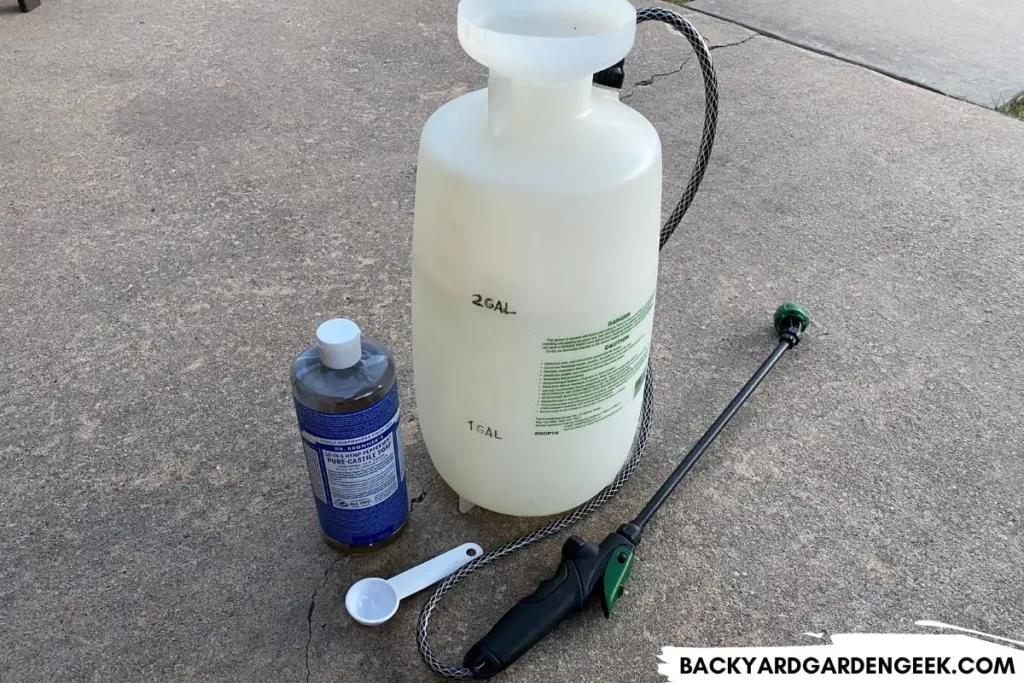
Soapy water is a natural and effective way to get rid of ants in your garden, so here’s a step-by-step recipe for making an effective soapy water spray:
- Fill a 1- or 2-gallon sprayer with water (1.8-3.6 L).
- Add 2-5 tablespoons of liquid dish soap per gallon of water (15-30 ml).
- Shake the sprayer well to mix the soap and water.
- Spray the solution directly on the ant colonies, on the ants themselves, and on any ant trails you see in your garden.
- Spray the solution on any aphids that you see among your plants. Be sure to spray the undersides of the leaves since aphids like to hide there.
- Repeat the spray every few days until you no longer see any ants or aphids.
Please keep in mind that soapy water can also kill beneficial insects in your garden, so use it carefully and later in the day, when most pollinators are no longer active.
Of course, you can vary the strength of the solution by adjusting how much soap you put in the sprayer. By using soapy water, you can get rid of ants in your garden without resorting to harmful chemicals, making it an eco-friendly solution to ant problems.
I’ve written about using soapy water on aphids and spider mites, so if you’ve never done so, I highly recommend this spray since it’s easy to make and safe for your plants.
2. Orange Oil Spray
Orange oil is another natural insecticide that’s highly effective in killing ants. It works by breaking down the ants’ exoskeleton and killing them.
There are so many options available for purchase, so the best step is to visit this Amazon list, take a look at what’s there, then buy the product that works best for you.
Medina is a great brand that I’ve used successfully in my garden. Green Gobbler is another brand that I’ve heard good things about from my gardening friends (although I haven’t used it myself yet).
Simply put, orange oil is less toxic than commercial insecticides, so it’s a great choice for those who want to avoid using harsh chemicals in their gardens.
3. Neem Oil

Neem oil is a safe and non-toxic alternative to chemical insecticides, making it an ideal choice for those who want to control ants in their garden without harming the environment.
Here’s what you need to do to make an effective neem oil spray:
- Fill a 1/2 gallon garden sprayer with water.
- Add 1 tablespoon (30 ml) of cold-pressed neem oil to the water.
- Add 1/2 tablespoon (15 ml) of liquid dish soap to help the oil mix with the water. I prefer Dr. Bronner’s Peppermint Castile Soap for my neem oil sprays.
- Shake the bottle well to mix the ingredients.
- Spray the solution directly on the ant colonies and any ant trails you see in your garden.
- Repeat the spray every few days until you no longer see any ants.
Be sure to apply the neem oil in the late afternoon or early evening to avoid exposing your pea plants to direct sunlight, which can damage them.
If you’ve never used neem oil in your garden below, you’ll want to learn as much as possible before spraying your plants with it. I recommend these articles for those who don’t have much experience with neem oil but want to learn how to use it:
- 9 Reasons Your Neem Oil Might Not Be Working
- Can You Use Too Much Neem Oil on Plants?
- Don’t Use Neem Oil on These Garden Plants
- How Can I Make Neem Oil More Effective? My 10-Step Process
- How Long Does It Take for Neem Oil to Kill Bugs?
- How Long Does Neem Oil Last? A Complete Shelf Life Guide
If you read those 6 articles, I think you’ll know all you need to know to use neem oil effectively in your garden.
Be careful with pea plants if you do. They’ve got somewhat fragile foliage, and you can easily burn them with neem oil if you spray too early in the afternoon.
4. Pyrethrin Spray
Pyrethrins are a type of insecticide that are derived from chrysanthemum flowers, and they’re highly effective in killing ants and other insects.
It’s important to follow the instructions on the label of the pyrethrin product you are using, as the amount of concentrate needed can vary depending on the brand.
Additionally, some plants may be sensitive to pyrethrin, so it’s a good idea to test the spray on a small area of your garden before using it more widely.
Here’s what you can do:
- Fill a 1/2 gallon or 1-gallon garden sprayer with water.
- Add the recommended amount of pyrethrin insecticide concentrate to the water, as listed on the label of the product you are using.
- Shake the bottle well to mix the ingredients.
- Spray the solution directly on ant colonies and any ant trails you see in your garden.
Pyrethrins are highly toxic to ants, but they’re also highly toxic to other beneficial insects, so follow all instructions on the package whenever using them and do your best not to spray too excessively.
5. Diatomaceous Earth
Diatomaceous earth (DE) is a chalk-like powder that’ll harm many different insects.
It works by puncturing and dehydrating insects’ exoskeletons. The tiny, sharp edges of diatomaceous earth particles won’t hurt humans or animals, but they’ll damage insects, causing them to dry out and die.
Simply buy food-grade diatomaceous earth and sprinkle the DE powder around the base of your pea plants and around the ants’ nests. Diatomaceous earth is non-toxic and safe for use in your garden.
You can even dust plants with it in extreme cases. I’ve used diatomaceous earth on flea beetles (since those little pests tolerate soapy water and neem oil), and it works great on them.
But you’ve got to be careful because the particles will harm and kill off beneficial bugs as well, so only use diatomaceous earth around the base of your plants or in the case of extreme infestations.
6. Boric Acid
Not to be confused with Borax, boric acid is a type of insecticide that’s highly effective in killing ants in that it works by causing the ants to dehydrate and die.
To create your own boric acid ant traps, follow these simple steps:
- Get 1 cup of something that ants love. I recommend peanut butter since it’s relatively affordable.
- Mix 1 teaspoon (15 ml) of boric acid together with the peanut butter.
- Place globs of this mixture near the areas where you’re having ant problems.
The ants will be attracted to the peanut butter, and in the process of gathering and eating it, they’ll pick up the boric acid as well. They’ll then carry it back to the colony, and the other ants will consume the bait and die shortly thereafter.
One word of caution: Boric acid is toxic when consumed, so please don’t use boric acid traps in your garden if you’ve got children or pets around.
7. Repellent Materials
Repellents stands for an entire group of products that can repel ants, typically through smells that ants dislike and wish to avoid.
There are many different types of repellents available–from mint leaves to cinnamon powder to citrus peels, cucumber peel juice, and peppermint oils.
I don’t love these methods because a) they’re typically short-lasting and b) they’re not as easy as spraying plants with soapy water or citrus oil.
But you can definitely experiment with placing mint leaves or cinnamon powder or citrus peels around your plants or creating sprays using cucumber peels or peppermint oil.
Here’s a few articles you might take a look at if you’re considering this sort of thing:
- Ant Prevention with Essential Oils: Are They Safe for Cats?
- Do Ants Hate the Smell of Peppermint? Here’s What to Know
- Preventing Ants with Essential Oils + Keeping Dogs Safe
What Are Ants on My Black-Eyed Peas?
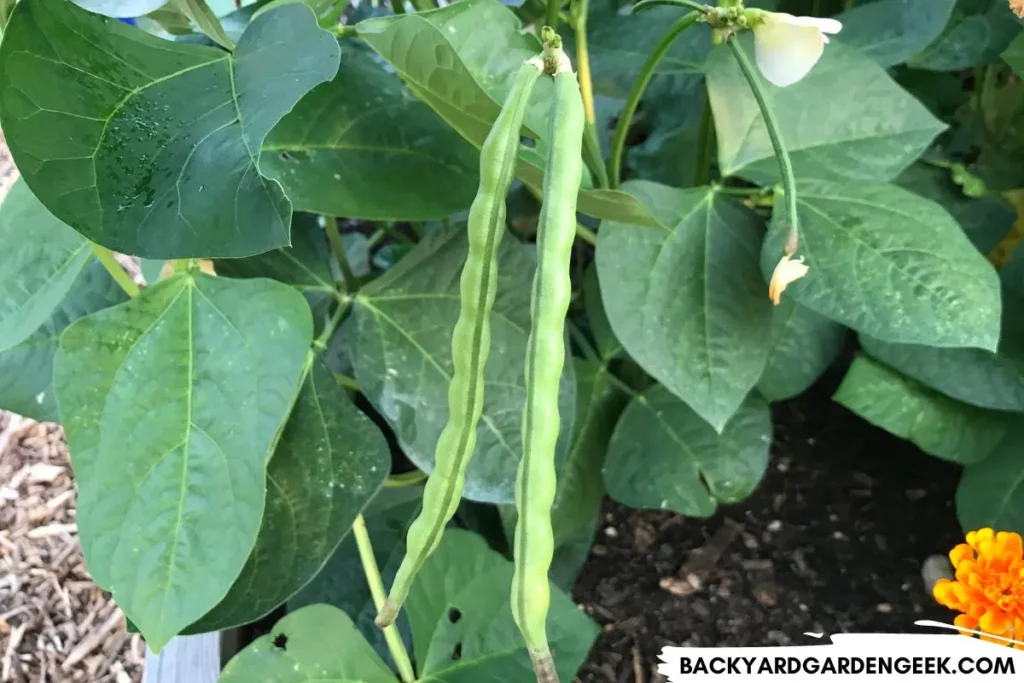
I’ve grown both peas and black-eyed peas, and I’ve seen ants on both, so I wanted to clarify:
Black-eyed peas, also known as cowpeas, are actually a type of bean, not a type of pea, but ants are attracted to black-eyed peas for the exact same reasons that they’re attracted to pea plants.
With this in mind, you should be on the lookout for the same causes and deploy the same pest management strategies for cowpeas that you would for peas. By using the same methods as for controlling ants on pea plants, you can keep ants at bay and enjoy a great harvest from your black-eyed pea plants.
Looking at these topics from a broader perspective, it’s important to remember that ants on pea plants can be a nuisance, but they’re also a sign of a normal garden ecosystem.
To get rid of ants, it’s important to understand why they’re attracted to your pea plants in the first place and to use pest control methods that are organic and thus safe for your plants and family.
Getting rid of ants on your pea plants requires patience and persistence, but with the right methods and understanding, you can enjoy a garden free of ant problems. Good luck!
Further Information
If you’d like to learn more about these topics, check out these related articles:

